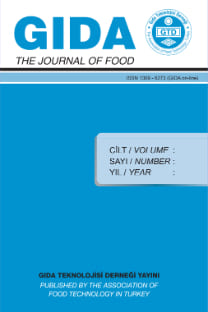Characterization of, and 5-hydroxymethylfurfural concentration in carob pekmez
Keçiboynuzu pekmezinin karakteristiği ve 5-hidroksimetilfurfural içeriği
___
- 1. Petit MD, Pinilla JM. 1995. Production and purifica- tion of a sugar syrup from carob pods. Lebensm-Wiss Technol, 28 (1), 145-152.
- 2. Battle I, Tous J. 1997. Carob Tree (Ceratonia siliqua L.). International Plant Genetic Resources Institute. Rome: Via delle Sette Chiese. 97 p.
- 3. Karkacier M, Artik N, Certel M. 1995. The conditions for carob (Ceratonia siliqua L.) extraction and the clarifi- cation of the extract. Fruit Processing, 12, 394-397.
- 4. Kumazawa S, Taniguchi M, Suzuki Y, Shimura M, Kwon M, Nakayama T. 2002. Antioxidant activity of polyphenols in carob pods. J Agr Food Chem, 50 (2), 373- 377.
- 5. Biner B, Gubbuk H, Karhan M, Aksu M, Pekmezci M. 2007. Sugar profiles of the pods of cultivated and wild types of carob bean (Ceratonia siliqua L.) in Turkey. Food Chem, 100 (4), 1453-1455.
- 6. Batu, A. 2005. Production of Liquid and White Solid Pekmez in Turkey. J Food Quality, 28, 417-427.
- 7. Sengul M, Ertugay MF, Sengul M. 2005. Rheological, physical and chemical characteristics of mulberry pek- mez. Food Control, 16 (1), 73-76.
- 8. Yogurtcu H, Kamisli F. 2006. Determination of rheo- logical properties of some pekmez samples in Turkey. J Food Eng, 77 (4), 1064-1068.
- 9. Roseiro JC, Girio FM, Collaco MTA. 1991. Yield imp- rovements in carob sugar extraction. Process Biochem, 26 (3), 179-182.
- 10. Simsek A. 2000. Research on the composition of dif- ferent fruit concentrate. Master’s Thesis, Ankara Univer- sity Graduate School of Natural and Applied Sciences, Ankara, Turkey, p, (In Turkish)
- 11. Simsek A, Artik N, Baspinar E. 2004. Detection of raisin concentrate (pekmez) adulteration by regression analysis method. J Food Compos Ana, 17 (2), 155-163.
- 12. Batu A, Karagöz DD, Kaya C, Yıldız M. 2007. Chan- ges on some quality values of mulberry and harnup pekmezs during storage. Gıda Teknolojileri Elektronik Dergisi, 2: 7-16.
- 13. Owen RW, Haubner R, Hull WE, Erben G, Spiegel- halder B, Bartsch H, Haber B. 2003. Isolation and struc- ture elucidation of the major individual polyphenols in carob fibre. Food Chem Toxicol, 41 (12), 1727-1738.
- 14. Makris DP, Kefalas P. 2004. Carob pods (Ceratonia siliqua L.) as a source of polyphenolic antioxidants. Food Technol Biotech, 42 (2), 105-108.
- 15. Yousif AK, Alghzawi HM. 2000. Processing and cha- racterization of carob powder. Food Chem, 69 (3), 283- 287.
- 16. Lee HS, Nagy S. 1990. Relative reactivities of sugars in the formation of 5-hydroxymethylfurfural in sugar- catalyst model systems. Food Process Pres, 14 (3), 171- 178.
- 17. Gogus F, Bozkurt H, Eren S. 1998. Nonenzymic brow- ning reactions in multi sugar and amino acid systems. Food Process Pres, 22 (2), 81-90.
- 18. O’Brien J, Morrisey P. 1989. Nutritional and toxicolo- gical aspects of the Maillard browning reaction in foods. Crit Rev Food Sci, 28 (3), 211-248.
- 19. Kus S, Gogus F, Eren S. 2005. Hydroxymethyl furfural content of concentrated food products. Int J Food Prop, 8 (2), 367-375.
- 20. Tosun I. Ustun NS. 2003. Nonenzymic browning du- ring storage of white hard grape pekmez (Zile pekmezi). Food Chem, 80 (4), 441-443.
- 21. Anon 2007. Üzüm Pekmezi Tebliği. Türk Gıda Ko- deksi. Tebliğ No: 2007/27. T.C. Official Gazette. 15 June 2007. Friday, Number: 26553, Ankara
- (22) AOAC. 1995. Official method of analysis, 17th ed. Gaithersburg, MD, USA. Method no. 925.45, 932.12, 942.15, 981.12, 984.24, 945.66 and 923.09. Association of Official Analytical Chemists.
- 23. James GS. 1995. Analytical chemistry of foods. Lon- don: Blackie Academic and Professional. 224 p.
- 24. Spanos GA. Wrolstad RE. 1990. Influence of proces- sing and storage on the phenolic composition of Thomp- son seedless grape juice. J Agr Food Chem, 38 (7), 1565- 1571.
- 25. Anon. 1996. Determination of hydroxymethylfurfu- ral. IFU Analysis No:69, 3 p.
- 26. Anon. 1999. The SAS System. Version 8. SAS Institu- te, Inc, Cary, NC.
- 27. Anon. 2005. General standard for the labelling of prepackaged foods. ftp://ftp.fao.org/codex/Publicati- ons/Booklets/Labelling/foodlabelling_2007EN.pdf (ac- cessed March, 17, 2008).
- 28. Rossi M, Giussani E, Morelli R, Lo Scalzo R, Nani RC, Torreggiani D. 2003. Effect of fruit blanching on phenolics and radical scavenging activity of highbush blueberry juice. Food Res Int, 36 (9-10), 999-1005.
- 29. Turhan I, Tetik N, Aksu M, Karhan M, Certel M. 2006. Liquid-solid extraction of soluble solids and total phenolic compounds of carob bean (Ceratonia siliqua L.). J Food Process Eng, 29 (5), 498-507.
- 30. Fennema, O. R. 1996. Food Chemistry (3rd ed.). New York: Marcel Dekker Inc., 1067 p.
- 31. Anon. 1981. Codex Standard for Honey. Codex Stan 12-1981. 8 p.
- ISSN: 1300-3070
- Yayın Aralığı: Yılda 6 Sayı
- Başlangıç: 1976
- Yayıncı: Prof. Dr. İbrahim ÇAKIR
Gülden Başyiğit KILIÇ, Aynur Gül KARAHAN
Seval Andiç Yusuf TUNÇTÜRK, Hüseyin GENÇCELEP
Hicaz Narı Şırasının Organik Asit Şeker ve Fenol Bileşikleri İçeriği Ve Antioksidan Kapasitesi
Gıdaların Muhafazasında Bakteriyosin ve Bakteriyofaj Uygulamaları
A. Kemal SEÇKİN, Emrah BALADURA
Characterization of, and 5-hydroxymethylfurfural concentration in carob pekmez
İrfan TURHAN, Nedim TETİK, Hatice Reyhan ÖZİYCİ, Mustafa KARHAN
Kakao Tozu ile Aromatize Edilmiş Geleneksel Salep İçeceğinin Reolojik Özellikleri (İngilizce)
Rheological characteristics of traditional salep drink flavored vith cocoa powder
Keçiboynuzu Pekmezinin Karakteristiği ve 5-Hidroksimetilfurfural İçeriği (İngilizce)
Nedim TETİK, İrfan TURHAN, Mustafa KARHAN, Hatice Reyhan ÖZİYCİ
